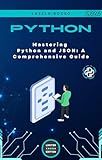Best JSON Parsing Tools in Swift to Buy in November 2025
In Swift, decoding nested JSON data involves several steps. Here's a step-by-step guide on how to decode nested JSON in Swift:
- Define a struct or class that represents the structure of your JSON data.
- Ensure that your struct or class conforms to the Codable protocol. This allows Swift's JSONDecoder to convert JSON data into instances of your custom type.
- Identify the nested JSON objects or arrays within your JSON data.
- Create nested structs or classes that represent these nested structures, following steps 1 and 2 for each of them.
- Add coding keys to your struct or class if the JSON key names differ from your property names. This helps the decoder match the keys in the JSON data with the corresponding properties in your struct or class.
- Implement the necessary initializer methods to decode the nested JSON data.
- Use the JSONDecoder class to perform the decoding process.
Here's an example:
struct Parent: Codable { let name: String let age: Int let child: Child }
struct Child: Codable { let name: String let age: Int }
// Create a JSON data string let jsonData = """ { "name": "John", "age": 35, "child": { "name": "Emily", "age": 5 } } """.data(using: .utf8)!
do { // Decode the parent object let parent = try JSONDecoder().decode(Parent.self, from: jsonData)
// Access the nested data
print(parent.name) // Output: John
print(parent.child.name) // Output: Emily
} catch { print("Error decoding JSON: \(error)") }
In the example above, we have a nested JSON object where a parent object contains a child object. By defining corresponding structs (Parent and Child) and their properties, and conforming to the Codable protocol, we can easily decode the JSON data using JSONDecoder and access the nested values.
Remember to handle any errors that may occur during the decoding process, such as malformed JSON data or mismatches between the JSON structure and your struct or class definition.
How to handle nested JSON objects in Swift?
To handle nested JSON objects in Swift, you can use the JSONSerialization class provided by the Foundation framework. Here's an example of how you can handle nested JSON objects in Swift:
- Convert the JSON data into a Foundation object using JSONSerialization.
import Foundation
// Assuming jsonData is the JSON data you want to handle if let json = try? JSONSerialization.jsonObject(with: jsonData, options: []) { // JSON data successfully converted to Foundation object // Continue with handling the nested JSON objects }
- Access the nested JSON objects by casting the Foundation object to the appropriate types.
// Assuming json is the Foundation object representing the JSON data if let dictionary = json as? [String: Any] { // Access the nested JSON objects using dictionary[key] notation
if let nestedDictionary = dictionary\["nestedObject"\] as? \[String: Any\] {
// Access the nested JSON objects inside the "nestedObject" key
if let nestedArray = nestedDictionary\["nestedArray"\] as? \[Any\] {
// Access the nested JSON array inside the "nestedArray" key
for element in nestedArray {
// Handle each element in the nested array
}
}
}
}
You can continue casting and accessing further nested objects or arrays as required. Remember to safely unwrap optionals and handle errors appropriately when dealing with nested JSON objects.
How to decode JSON with variable keys in Swift?
To decode JSON with variable keys in Swift, you can use the Codable protocol along with custom coding keys. Here's a step-by-step guide to decode JSON with variable keys in Swift:
- Define a struct or class that conforms to the Codable protocol. This struct or class will represent the JSON data you want to decode.
struct MyData: Codable { // Declare properties to represent the JSON data }
- Implement the init(from decoder: Decoder) initializer method to provide custom decoding logic.
init(from decoder: Decoder) throws { let container = try decoder.container(keyedBy: CodingKeys.self)
// You can now access the JSON keys using the CodingKeys enum
// Write custom decoding logic depending on the variable keys
// Example: decoding an array with variable keys
let dynamicKeys = container.allKeys
for key in dynamicKeys {
// Access the values using the dynamic keys
let value = try container.decode(String.self, forKey: key)
// Implement your own logic to handle the values
}
}
- Define a nested enum called CodingKeys inside the struct or class. The cases of the enum represent the JSON keys. Use the stringValue property to dynamically decode the JSON keys.
private enum CodingKeys: CodingKey { // Define cases to represent the JSON keys case stringValue(String)
init?(stringValue: String) {
// Implement custom logic to handle the variable keys
}
// Required initializer for non-variable keys
init?(intValue: Int) {
return nil
}
}
- Implement the encode(to encoder: Encoder) method if you also want to encode the struct or class back to JSON format.
func encode(to encoder: Encoder) throws { var container = encoder.container(keyedBy: CodingKeys.self)
// You can now access the JSON keys using the CodingKeys enum
// Write custom encoding logic depending on the variable keys
// Example: encoding an array with variable keys
for (key, value) in someArray {
// Use the key to encode the value
try container.encode(value, forKey: CodingKeys.stringValue(key))
// Implement your own logic to handle the values
}
}
With this approach, you can decode JSON with dynamic or variable keys in Swift. Remember to customize the init(from:) initializer and CodingKeys enum to fit the specific JSON structure you're working with.
How to handle nested JSON arrays in Swift?
To handle nested JSON arrays in Swift, you can use the Codable protocol introduced in Swift 4.0. The Codable protocol allows you to easily encode (serialize) and decode (deserialize) data from and to JSON format.
Here's an example of how to handle nested JSON arrays using Codable:
- Define your data structure:
struct Person: Codable { let name: String let age: Int let hobbies: [String] }
struct PeopleResponse: Codable { let people: [Person] }
- Parse the JSON data:
let jsonString = """ { "people": [ { "name": "John", "age": 25, "hobbies": ["reading", "coding"] }, { "name": "Jane", "age": 30, "hobbies": ["painting", "dancing"] } ] } """
let jsonData = jsonString.data(using: .utf8)!
do { let decoder = JSONDecoder() let response = try decoder.decode(PeopleResponse.self, from: jsonData)
for person in response.people {
print("Name: \\(person.name), Age: \\(person.age), Hobbies: \\(person.hobbies)")
}
} catch { print("Error: \(error.localizedDescription)") }
Output:
Name: John, Age: 25, Hobbies: ["reading", "coding"] Name: Jane, Age: 30, Hobbies: ["painting", "dancing"]
In this example, we define two data structures: Person and PeopleResponse. Person represents an individual person with name, age, and hobbies. PeopleResponse represents the response containing an array of Person objects.
We then use the JSONDecoder class to decode the JSON data into a PeopleResponse object. The decoded object can then be accessed through the response variable. We can iterate over the people array and access individual properties of each Person object.
Note: Make sure your data structure matches the structure of your JSON data for successful decoding.
How to parse nested JSON in Swift?
To parse nested JSON in Swift, you can use the Codable protocol in combination with the JSONDecoder class. Here's an example of how to do it:
- Define your nested JSON structure as Swift structs or classes. Make sure to conform to the Codable protocol.
struct InnerData: Codable { let id: Int let name: String }
struct OuterData: Codable { let innerData: InnerData }
- Convert the JSON data into your nested structure using JSONDecoder.
let jsonData = """ { "innerData": { "id": 1, "name": "Nested JSON" } } """.data(using: .utf8)!
let decoder = JSONDecoder() do { let outerData = try decoder.decode(OuterData.self, from: jsonData) print(outerData.innerData) } catch { print("Error: \(error)") }
The decode(_:from:) method of JSONDecoder will automatically convert the JSON data into your nested structure.
In this example, the output will be:
InnerData(id: 1, name: "Nested JSON")
By defining your nested JSON structure as Swift structs or classes and using the Codable protocol, you can easily parse nested JSON in Swift.
What is the structure of nested JSON objects in Swift?
In Swift, nested JSON objects are represented using dictionaries and arrays.
A JSON object is represented by a dictionary in Swift, where the keys are of type String and the values can be of any valid JSON type (string, number, boolean, null, array, or another nested JSON object).
Here's an example of a nested JSON object structure in Swift:
let jsonObject: [String: Any] = [ "key1": "value1", "key2": 123, "key3": true, "key4": [ "nestedKey1": "nestedValue1", "nestedKey2": [ "innerKey1": "innerValue1", "innerKey2": "innerValue2" ] ] ]
In this example, jsonObject is a dictionary with four key-value pairs. The value for "key4" is another dictionary that represents a nested JSON object structure. Similarly, the nested dictionary contains a key-value pair for "nestedKey2", where the value is another dictionary representing further nesting.
To access values from nested JSON objects, you can use subscript notation and type casting. For example:
if let nestedKey2 = jsonObject["key4"] as? [String: Any], let innerValue2 = nestedKey2["nestedKey2"] as? [String: String], let value = innerValue2["innerKey2"] { print(value) // Output: innerValue2 }
In this code snippet, it first checks if "key4" exists in the top-level dictionary, then type casts it to [String: Any]. Similarly, it checks for "nestedKey2" inside the nested dictionary and finally extracts the value for "innerKey2".



